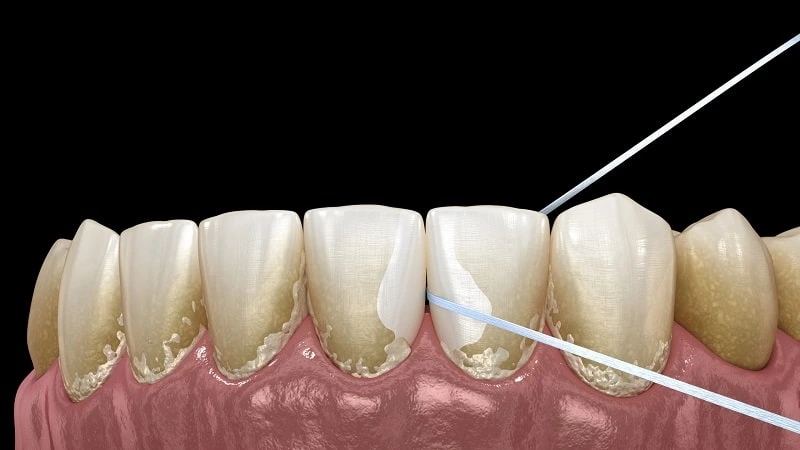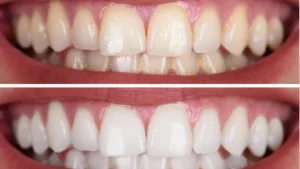Maintaining a healthy smile isn’t just about showing off pearly whites; it’s about feeling confident in your interactions and making a positive impression. Have you ever wondered, “Does flossing help with bad breath?” Well, wonder no more! Bad breath, often called halitosis, can be a real confidence-shaker, affecting how we connect with others.
That’s where flossing comes in – a simple practice with a big impact. By learning how flossing fights bad breath, you’re on your way to a fresher, more enjoyable social experience. Let’s explore how this small step can make a huge difference in your daily life.
Causes of Bad Breath (Halitosis)
- Oral Bacteria: Tiny organisms living in your mouth can produce foul-smelling compounds when they break down leftover food particles.
- Food Particles: Food that gets stuck between teeth can become a breeding ground for bacteria, leading to unpleasant odors.
- Gum Disease: Inflamed gums caused by bacterial buildup can release smelly gases that contribute to bad breath.
- Dry Mouth: A lack of saliva reduces the mouth’s natural cleaning process, allowing bacteria to flourish and cause odor.
Significance of Addressing Bad Breath
- Social Interactions: Bad breath can create discomfort and hinder open conversations, affecting personal and professional relationships.
- Self-Confidence: Dealing with bad breath can boost self-assurance, making you feel more at ease in various situations.
Read More: Oral Hygiene with Braces: Tips for Keeping Your Teeth Clean and Healthy

Does Flossing Help with Bad Breath?
Flossing, a simple but powerful habit, plays a crucial role in maintaining oral hygiene and combating bad breath.
Removal of Food Particles and Bacteria
By flossing daily, you reach the spaces between your teeth that a toothbrush can’t access. This action removes hidden food particles, which, when left untouched, can contribute to bad breath.
Reaching Areas Inaccessible to Brushing
Flossing gets into tight spots where toothbrush bristles can’t go, ensuring thorough cleaning of the entire tooth surface.
Preventing Gum Disease and Inflammation
Regular flossing helps prevent gum disease by removing plaque that can cause irritation and lead to smelly breath.
Optimal Way to Floss
Select a suitable dental floss, wrap it gently around your fingers, and glide it between each tooth with a sawing motion.

Choosing the Right Type of Dental Floss
Select a floss that suits your preference and dental needs. Options include waxed, unwaxed, flavored, or tape floss. Find what works best for you.
Proper Flossing Frequency
Floss at least once daily to maintain optimal oral health and prevent bad breath. Consistency is key to reaping the benefits.
Read More: Does Vaping Make Your Teeth Yellow?
Step-by-Step Flossing Process
- Unwinding and Holding the Floss: Take about 18 inches of floss and wind most of it around your middle fingers. Leave a small section for flossing.
- Guiding the Floss Between Teeth: Use your thumbs and index fingers to gently guide the floss between your teeth. Be careful not to snap it, protecting your gums.
- Forming a C Shape Around Each Tooth: Curve the floss around the base of each tooth, creating a C shape. Glide it gently under the gumline.
- Sliding the Floss Up and Down: Move the floss up and down against the tooth surface, ensuring thorough cleaning on both sides of each tooth.
Flossing Tips for Optimal Results
- Be Gentle: Avoid forceful movements that could harm your gums.
- Use Clean Sections: Move to a fresh section of floss as you move from tooth to tooth.
- Rinse Afterwards: Rinse your mouth to remove dislodged particles and ensure a refreshing feeling.
Conclusion
In the journey to conquer bad breath, flossing emerges as a potent ally. Armed with the knowledge of its significance, you can take proactive steps toward maintaining optimal oral health and enjoying the benefits of fresher breath.
By removing food particles and bacteria that evade toothbrushes, flossing plays a vital role in preventing bad breath.
Moreover, its ability to reach challenging spaces between teeth ensures comprehensive cleaning and contributes to gum health.
Embrace proper flossing techniques as an essential part of your daily routine, complementing brushing and mouthwash for a holistic approach.
Remember, beyond hygiene, your confidence and social interactions can be significantly enhanced through fresh breath.
FAQs about Flossing and Bad Breath
Does flossing really help with bad breath?
Yes, flossing helps by removing food particles and bacteria that can contribute to unpleasant odors.
How often should I floss?
Floss at least once daily to maintain oral hygiene and keep bad breath at bay.
Can using a mouthwash replace flossing?
While mouthwash is helpful, it can’t replace the physical action of removing debris that flossing provides.
What type of floss is best for me?
Choose floss that suits your preference, such as waxed, unwaxed, or flavored. The key is to use it regularly.
Is it normal for my gums to bleed when I floss?
Occasional bleeding can happen if you’re new to flossing, but persistent bleeding may indicate gum issues and warrants a dental checkup.
Can flossing prevent gum disease?
Yes, regular flossing helps prevent gum disease by removing plaque buildup that can lead to inflammation.
Should I floss before or after brushing?
It’s better to floss before brushing to dislodge particles, making it easier for toothpaste to clean effectively.
Can bad breath be a sign of a serious health problem?
In some cases, persistent bad breath can indicate underlying health issues such as diabetes or respiratory infections.
Can flossing improve my overall health?
Maintaining good oral health, including flossing, is linked to overall well-being, as oral health can impact various bodily systems.
References
- American Dental Association. (2020). Flossing: What is it good for? [Online Article].
- Slot, D. E., & Dörfer, C. E. (2015). Van der Weijden, GA: The efficacy of interdental brushes on plaque and parameters of periodontal inflammation: a systematic review. International Journal of Dental Hygiene, 13(4), 251-257.
- Al-Zahrani, M. S. (2007). The effect of miswak (chewing stick) and toothbrushing on oral health: A comparative study. Journal of Contemporary Dental Practice, 8(3), 27-34.
- Yaacob, M., Worthington, H. V., Deacon, S. A., Deery, C., Walmsley, A. D., Robinson, P. G., … & Glenny, A. M. (2012). Powered versus manual toothbrushing for oral health. Cochrane Database of Systematic Reviews, (6).
- Van der Weijden, F. A., Slot, D. E., & Rosema, N. A. (2015). Toothbrushing behaviour in Europe: opportunities for targeting of oral hygiene interventions. International Dental Journal, 65(5), 241-250.
- Slot, D. E., Dorfer, C. E., & Van der Weijden, G. A. (2008). The efficacy of interdental brushes on plaque and parameters of periodontal inflammation: a systematic review. International Journal of Dental Hygiene, 6(4), 253-264.



